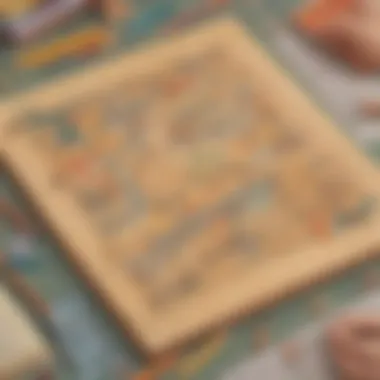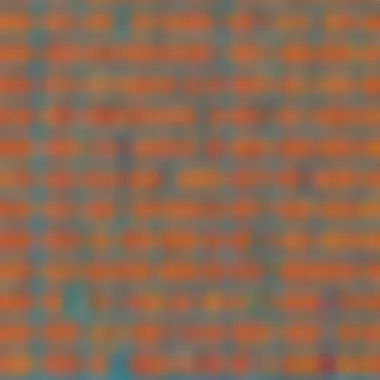Unlocking Perimeter Mastery: A Complete Guide for Elementary School Kids


Creative Activities
In this section, we will explore various creative activities to help elementary school children master the concept of perimeter in an engaging and interactive manner. Craft ideas will be shared, providing children with hands-on experiences to solidify their understanding. Step-by-step guides will accompany each activity, offering detailed instructions that are easy to follow. These activities are not only fun but also carry significant educational value, enhancing children's mathematical skills in a practical and enjoyable way.
Fun Quizzes
Moving on to fun quizzes, these will cover a range of topics related to perimeter. The quizzes available on Elem Fun will include diverse question types aimed at keeping children engaged and challenged. Through these quizzes, children will reinforce their knowledge of perimeter concepts, ensuring retention and application of what they have learned.
Fact-Based Articles
Lastly, fact-based articles will complement the learning experience by delving into various topics relevant to perimeter and mathematics as a whole. These articles will present information in an engaging and easy-to-understand manner, catering specifically to elementary school children. Additionally, links to external resources will be provided for those looking to explore the world of mathematics further. This holistic approach aims to deepen children's understanding of perimeter while fostering a love for learning and exploration.
Introduction to Perimeter
Perimeter forms the backbone of geometric understanding, serving as a fundamental concept that underpins various mathematical applications. In this comprehensive guide tailored for elementary school children, the significance of mastering perimeter lies in laying a strong foundation for more complex mathematical skills. By grasping the basics of perimeter, students can develop critical thinking, problem-solving abilities, and spatial awareness. Understanding perimeter not only enhances mathematical proficiency but also cultivates analytical skills essential for academic growth and real-world applications.
Understanding the Basics
Definition of Perimeter
The Definition of Perimeter encompasses the total distance around a two-dimensional shape. This crucial concept provides insights into measuring and analyzing the boundaries of geometric figures. Through grasping the Definition of Perimeter, students can effectively calculate the fencing needed for a garden or the frame required for a picture. Its practicality and convenience make it a popular choice for introductory mathematical education, offering a concrete method to quantify spatial attributes. The key characteristic of Definition of Perimeter lies in its simplicity and direct applicability, making it an ideal starting point for young learners to engage with geometrical concepts in a tangible manner.
Importance of Perimeter
The Importance of Perimeter unfolds in its capacity to enhance spatial reasoning and promote geometric comprehension. By emphasizing the significance of Perimeter, students learn to evaluate and compare the sizes of shapes, fostering a solid understanding of proportion and measurement. Understanding the Importance of Perimeter equips children with the ability to solve real-life problems, such as determining the amount of material needed to enclose a designated area. Its unique feature lies in bridging abstract mathematical principles with practical scenarios, enabling students to visualize and apply mathematical concepts in everyday situations. Empowering students with a grasp of the Importance of Perimeter prepares them for more intricate mathematical challenges and encourages a holistic approach to problem-solving.


Common Units of Measurement
Inches and Centimeters
In the realm of geometric measurement, Inches and Centimeters serve as essential units for calculating perimeter. Inches offer a standard unit of measurement in the imperial system, commonly used in the United States, while Centimeters provide a metric alternative widely adopted across the globe. Understanding the intricacies of Inches and Centimeters equips students with versatile measurement tools, enabling them to express perimeter values in varying scales with precision. While Inches cater to localized contexts, Centimeters offer a universal metric that promotes global comprehension of geometric dimensions. Leveraging the strengths of both Inches and Centimeters allows students to navigate between different measurement systems, fostering adaptability and fluency in geometric calculations.
Feet and Meters
Feet and Meters emerge as crucial units in the realm of geometric measurement, offering distinctive advantages for calculating perimeter. Feet, a common imperial unit, provide a practical measurement scale often utilized in construction and architecture. In contrast, Meters represent a fundamental metric unit employed in scientific and international contexts, promoting standardized measurements across diverse applications. By mastering the intricacies of Feet and Meters, students gain proficiency in converting between imperial and metric systems, enhancing their mathematical acumen and global comprehension. The unique feature of Feet and Meters lies in their complementary roles, facilitating seamless transitions between measurement systems and fostering a comprehensive understanding of geometric dimensions.
Practical Applications of Perimeter
Perimeter plays a crucial role in our everyday lives, especially when it comes to measuring boundaries or determining how much fencing is needed for a garden. Understanding practical applications of perimeter helps us solve real-world problems with precision and accuracy. By mastering the calculation of perimeter for basic shapes like squares, rectangles, triangles, and circles, we develop a fundamental skill that finds use in various scenarios, from landscaping to construction projects. In this section, we will delve into how mastering practical applications of perimeter equips us with a valuable mathematical toolset that can be applied in a plethora of situations, emphasizing the importance of this fundamental concept for elementary school children.
Calculating Perimeter of Basic Shapes
Squares and Rectangles
Squares and rectangles are among the most common geometric shapes encountered in the real world. Their straight sides make them ideal for perimeter calculations, where adding all sides' lengths gives us the shape's perimeter. Understanding squares' and rectangles' properties is essential for calculating perimeter efficiently. Their straightforward formulas simplify the process, making them a popular choice for teaching perimeter concepts. While squares boast equal sides, rectangles feature two pairs of congruent sides, allowing for easier calculation. Despite their simplicity, squares and rectangles offer a solid foundation for mastering perimeter skills in elementary school, preparing students for advanced mathematical concepts.
Triangles and Circles
Unlike squares and rectangles, triangles and circles present unique challenges when calculating perimeter due to their curved or angled sides. Triangles require summing the lengths of all three sides to determine the perimeter, with additional consideration for different types of triangles like equilateral, isosceles, or scalene. Circles, on the other hand, involve calculating the circumference using the formula 2πr, where 'r' represents the circle's radius. Understanding triangles and circles expands students' geometric knowledge beyond straight-edged shapes, introducing them to more intricate perimeter calculations. While triangles test students' ability to identify and measure various side lengths accurately, circles offer a glimpse into the application of mathematical constants like pi (π) in real-world contexts.
Real-World Examples


Fencing a Garden
Fencing a garden exemplifies a practical application of perimeter, requiring precise measurement to determine the amount of fencing needed. By calculating the garden's perimeter, students can estimate how much fencing material will be required, showcasing the direct relevance of perimeter calculations in everyday situations. Considering factors like the garden's shape and size, students can apply their understanding of perimeter to solve practical problems efficiently. This exercise not only reinforces mathematical concepts but also fosters critical thinking and problem-solving skills.
Measuring Room Perimeter
Measuring a room's perimeter aids in various home improvement and interior design projects, emphasizing the significance of practical geometry in our environment. By calculating the room's perimeter, students can determine appropriate furniture placement, estimate the amount of paint needed for walls, or calculate the length of baseboards required. This real-world example showcases how mastering perimeter skills goes beyond theoretical knowledge, directly impacting our daily lives through enhanced spatial awareness and measurement proficiency.
Strategies for Learning Perimeter
Strategies for Learning Perimeter are pivotal in enhancing the understanding and mastery of this fundamental mathematical concept. By employing visualization techniques and interactive tools, students can grasp perimeter with ease. Visualization allows children to see geometric shapes in a tangible way, aiding in comprehension and problem-solving skills. In this article, we emphasize the significance of engaging strategies that make learning enjoyable and effective.
Visualization Techniques
Drawing Diagrams
Drawing Diagrams play a crucial role in simplifying complex geometric concepts for young learners. These visual representations illustrate the relationship between sides and help students visualize perimeter calculation methods. The clarity offered by diagrams enhances understanding and retention, making them a valuable tool in mastering perimeter. Their simplicity and direct approach make drawing diagrams an excellent choice for elucidating geometric concepts effectively.
Using Manipulatives
Manipulatives serve as hands-on tools that enable students to physically interact with geometric shapes and measurements. By manipulating objects such as blocks or shapes, children can internalize the concept of perimeter through tactile engagement. Utilizing manipulatives fosters a deeper understanding of spatial relationships and enhances problem-solving skills. While they may require additional setup and supervision, their tangible nature offers a unique advantage in reinforcing perimeter concepts.
Interactive Learning Tools
Online Perimeter Games


Online Perimeter Games inject an element of fun and interactivity into learning, making the concept of perimeter engaging and memorable for young learners. These games present practical scenarios where students can apply their knowledge of perimeter in a dynamic way, fostering critical thinking and strategic planning. The gamified approach not only maintains children's interest but also reinforces learning outcomes effectively.
Perimeter Worksheets
Perimeter Worksheets provide structured exercises that allow students to practice perimeter calculations independently. These worksheets offer a systematic approach to applying mathematical concepts, reinforcing problem-solving skills and mathematical fluency. By offering varied challenges and scenarios, perimeter worksheets cater to different learning styles and levels, facilitating a comprehensive understanding of perimeter concepts.
Mastering Perimeter Skills
Mastering Perimeter Skills is a crucial section in this article, dedicated to enhancing elementary school children's understanding of perimeter concepts. By focusing on key elements such as regular practice sessions and challenging exercises, young learners can elevate their mathematical skills to a higher level of proficiency. Considering the foundational nature of perimeter in geometry, mastering these skills early on sets a strong academic foundation for students.
Practice Makes Perfect
Regular Practice Sessions
Regular practice sessions play a pivotal role in reinforcing perimeter concepts in young minds. By engaging in consistent practice, children can internalize the formulae and techniques required to calculate perimeters accurately. The repetitive nature of these sessions helps in solidifying the understanding of perimeter-related principles, allowing students to apply them with ease in various problem-solving scenarios.
Challenge Exercises
Introducing challenge exercises to students can further amplify their mastery of perimeter skills. These exercises push children beyond their comfort zones, encouraging them to think critically and problem-solve creatively. By tackling complex challenges, students not only refine their perimeter calculation abilities but also develop resilience and perseverance in the face of academic hurdles.
Seeking Help and Guidance
Seeking help and guidance is an integral part of the learning process, especially when it comes to mastering perimeter skills. By consulting teachers, students can clarify doubts, receive personalized assistance, and gain valuable insights into effective perimeter practices. Teachers serve as mentors, guiding students towards a deeper comprehension of perimeter concepts and boosting their confidence in tackling mathematical problems.
Consulting Teachers
Consulting teachers offers a direct line of support and expertise for students navigating the intricacies of perimeter. Educators can provide tailored explanations, offer additional resources, and mentor students on optimal strategies for mastering perimeter calculations. The interactive nature of teacher consultations fosters a collaborative learning environment, empowering students to excel in their mathematical pursuits.
Asking for Peer Support
Engaging peers for support can create a conducive learning environment for students striving to master perimeter skills. By collaborating with classmates, children can discuss challenges, share strategies, and engage in peer-to-peer learning experiences. Peer support not only reinforces social bonds among students but also cultivates a community of learners committed to advancing their perimeter proficiency together.







